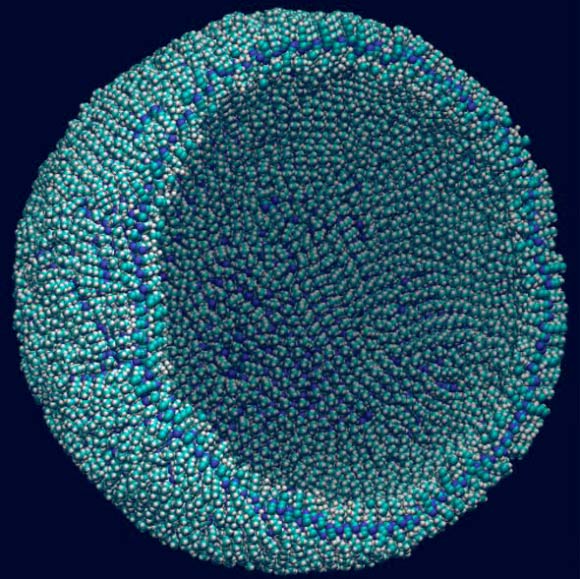Titan – a planetary body awash with seas not of water, but of liquid methane – could harbor oxygen-free, methane-based life forms, says a team of scientists at Cornell University.

Azotosome vesicle, the size of a small virus particle. Image credit: James Stevenson et al.
The team, led by Dr Paulette Clancy of the Cornell University’s School of Chemical and Biomolecular Engineering, modeled an azotosome – a new type of cell membrane composed of small organic nitrogen compounds and capable of functioning in liquid methane at temperatures of minus 292 degrees Celsius.
On our planet, life is based on the phospholipid bilayer membrane, the strong, permeable, water-based vesicle that houses the organic matter of every cell. A vesicle made from such a membrane is called a liposome.
Thus, many scientists seek alien life in what’s called the circumstellar habitable zone, the narrow band around the Sun in which liquid water can exist.
But what if cells weren’t based on water, but on methane, which has a much lower freezing point?
The azotosome is made from nitrogen, carbon and hydrogen molecules known to exist in the cryogenic seas of Titan, but shows the same stability and flexibility that Earth’s analogous liposome does.
This came as a surprise to Dr Clancy and her colleagues, who had never thought about the mechanics of cell stability before; they usually study semiconductors, not cells.
They employed a molecular dynamics method that screened for candidate compounds from methane for self-assembly into membrane-like structures.
The most promising compound they found is an azotosome based on acrylonitrile – a colorless, poisonous, liquid organic compound present in the atmosphere of Titan.
The acrylonitrile azotosome showed good stability, a strong barrier to decomposition, and a flexibility similar to that of phospholipid membranes on Earth.
Dr Clancy and her colleagues published their results in the journal Science Advances.
Now they plan to demonstrate how these cells would behave in the methane environment.
_____
James Stevenson et al. 2015. Membrane alternatives in worlds without oxygen: Creation of an azotosome. Science Advances, vol. 1, no. 1, e1400067; doi: 10.1126/sciadv.1400067







